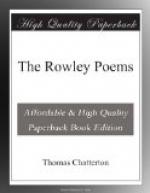This was the beginning of the Rowley fiction—which might be metaphorically described as a motley edifice, half castle and half cathedral, to which Chatterton all his life was continually adding columns and buttresses, domes and spires, pediments and minarets, in the shape of more poems by Thomas Rowley (a secular priest of St. John’s, Bristol); or by his patron the munificent William Canynge (many times Mayor of the same city); or by Sir Thibbot Gorges, a knight of ancient family with literary tastes; or by good Bishop Carpenter (of Worcester) or John a Iscam (a Canon of St. Augustine’s Abbey, also in Bristol); together with plays or portions of plays which they wrote—a Saxon epic translated—accounts of Architecture—songs and eclogues—and friendly letters in rhyme or prose. In short, this clever imaginative lad had evolved before he was sixteen such a mass of literary and quasi-historical matter of one kind or another that his fictitious circle of men of taste and learning (living in the dark and unenlightened age of Lydgate and the other tedious post-Chaucerians) may with study become extraordinarily familiar and near to us, and was certainly to Chatterton himself quite as real and vivid as the dull actualities of Colston’s Hospital and the Bristol of his proper century.
Chatterton’s own circle of acquaintance was far less brilliant. His principal patrons were Henry Burgum and George Catcott, a pair of pewterers, the former vulgar and uneducated but very ambitious to be thought a man of good birth and education, the latter a credulous, selfish and none too scrupulous fellow, a would-be antiquary, of whom there is the most delightfully absurd description in Boswell’s Johnson. The biographer relates that in the year 1776 Johnson and he were on a visit to Bristol and were induced by Catcott to climb the steep flight of stairs which led to the muniment room in order to see the famous ‘Rowley’s Cofre’.




